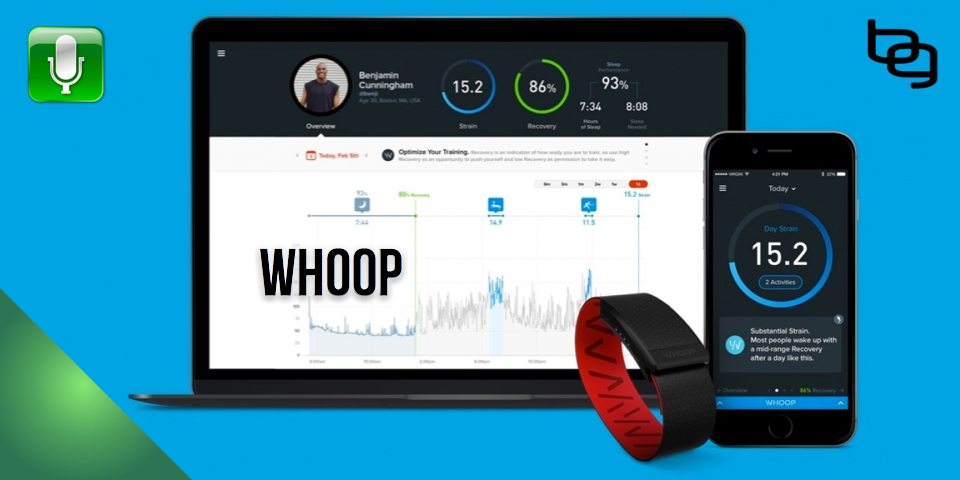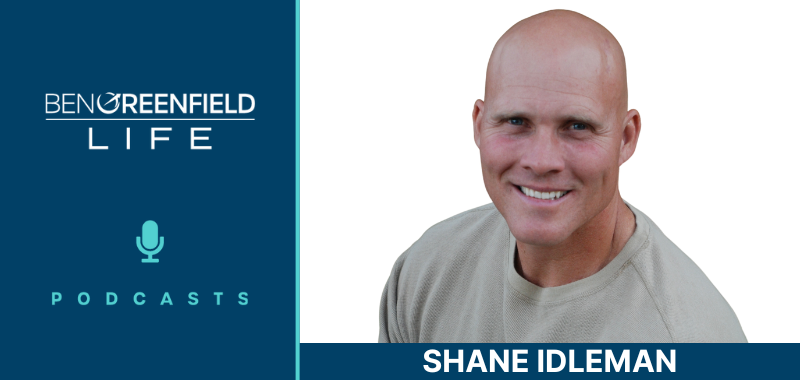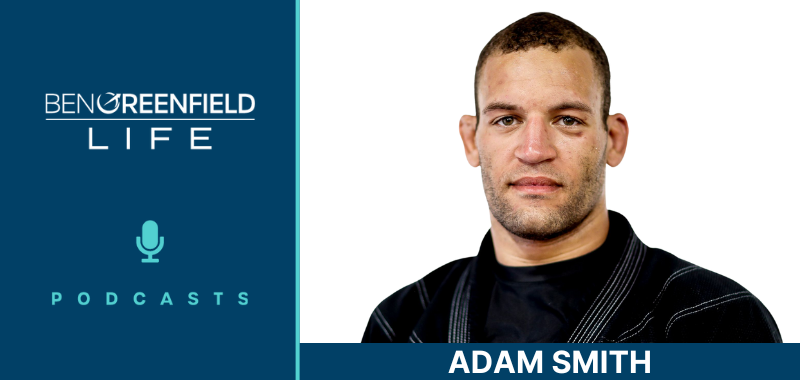January 7, 2017
Click here for the full written transcript of this podcast episode.
My guest on today's show – Will Ahmed – grew up loving sports and exercise. Many of his childhood heroes were athletes. He was recruited to Harvard and became Captain of the Men’s Varsity Squash Team. As a D1 athlete, he was amazed by how little he knew about his body. He would train for 3 or more hours a day with his teammates without knowing what gains he made. He was surrounded by athletes, himself included, who overtrained, misinterpreted fitness peaks, underestimated recovery and sleep, and got injured. Being prepared for game day often seemed…random.
So he became inspired by a simple idea: Humans, especially athletes, could optimize their daily performance. Optimizing performance was not a random sequence of events and decisions, but rather a systematic approach to understanding your body.
At Harvard, he met with cardiologists and physiologists. He read over 300 medical papers because he became obsessed with understanding the human body. What he learned was amazing: There are secrets that your body – your physiology – is trying to tell you. These secrets can help prevent overtraining and injury, they can detect fatigue and even sickness, and, sure enough, they can be used to optimize human performance. But few actually monitor those metrics.
He partnered with his co-founder John Capodilupo, who was studying math and statistics at Harvard before dropping out to found a self-quantification company called “WHOOP”, and also partnered with Aurelian Nicolae, a graduate from Harvard with a gift for mechanical prototyping and engineering. They then spent the past 4 years building a technology called “the WHOOP System”. They assembled a scientific and performance advisory board and now work alongside our team of 50 engineers, designers, and data scientists in a downtown Boston office overlooking Fenway Park.
They've been fortunate to work with many of the best athletes in the world. What they've discovered has amazed Will, and we talk about it all on today's show. Self quantification can transform your life and induce effects like positive behavior change, fitness improvements, injury reduction.
Will believes that the data he's collecting on athletes is unprecedented, both in its sophistication and scale, and that no physiological studies have ever occurred on this magnitude. WHOOP benefits from the fact that athletes also have tangible performance data (wins/losses, batting average, time trials, etc) across sports. They want to share this data: the unbelievable correlations between physiology and performance; the approach to health monitoring and the different ways to interpret or action your body’s feedback. Beyond building a product that people love, Will and the team at WHOOP hope to advance human knowledge with our discoveries.
During our discussion, you'll discover:
-The key defining characteristics that set WHOOP apart, including skin conductivity, accelerometer data, and continuous HRV monitoring…[13:25]
-Why WHOOP is the only company to measure the activity and fluctuations of the cardiac autonomic nervous system, particularly as it relates to recovery, training status, and training readiness…[13:57]
-The actual hard data being collected by the WHOOP, and HRV, pulse oximetry, temperature, respiration, etc.)…[15:30 & 24:30]
-Why the WHOOP uses a combination of PPG (photoplethysmography) sensors (4 LEDs and 1 Photodiode) along with 3-axis accelerometer, capacitive touch sensor, ambient temperature sensor…[18:17]
-How coaches and trainers can use WHOOP to monitor the sleep, training and recovery status of a large number of athletes and clients…[20:00, 30:00 , 35:50 & 47:50]
-Why the WHOOP has 90% sleep/wake accuracy compared to gold-standard sleep labs…[22:10]
-How the WHOOP sleep coach automatically calculates sleep needed based on your sleep baseline, any sleep debt that has accumulated over the last few nights, and any naps taken for that day…[39:15]
-The technology the WHOOP uses to tell you how much sleep you need and to give you a picture of when you should go to bed based on your habitual sleep efficiency and desired wake up time…[40:15]
-Why athletes like Lebron James and Michael Phelps are using the WHOOP…[59:15]
-And much more…
Resources from this episode:
–WHOOP (use code GREENFIELD for $50 off at checkout)
–How A Bear Attack Affects Your Sleep
Do you have questions, thoughts or feedback for Will or me? Leave your comments below and one of us will reply!














I have both the WHOOP and the OURA ring. I’ve worn them both at the same time at night and have gotten signficantly different numbers for REM and Deep sleep. I’d choose the OURA ring over WHOOP any day. Its more accurate, not to mention it doesn’t have two green LED lights shining on your skin all night which has been shown to negatively impact sleep!
Very useful info, thanks
I believe the study you are likely referring to has been debunked. The idea that two small LEDs on your wrist could affect your sleep isn’t substantiated. This isn’t just common sense, subsequent research found major flaws in the methodology of the study (the one that put blue light on the backs of subjects knees) that found that light on the skin could affect circadian rhythm. It was a faulty study – they had TVs playing loudly as well before sleep that were found to be the most likely cause of the results – rather than the lights.
I would think the feeling of the strap on your wrist would be far more likely to cause sleep disturbance than the affect of the lights.
Also, saying the Oura ring is more accurate isn’t a very accurate statement – it depends on what aspects you are talking about.
Thirdly, the strap won’t risk you degloving your finger, if that is the kind of thing you worry about or you work outside, climb, etc.
sorry for using the wrong affect/effect spelling
Hi again Ben,
it would be really awesome to read one of your in-depth full of insights articles comparing Oura and Whoop. I´m sure that both devices are quite different and both have stronger and weaker points. I can´t think of any fitness expert better than you to geek out with them and explain clearly what device is better suited for what kind of user and goals.
Thank you in advance!
David
Did anyone get conclusions on the EMF issue? That’s a deal-breaker
Hey Lisa, here's a response from WHOOP: The WHOOP Strap connects to mobile phones via Bluetooth Classic (2.1 w/ EDR). We comply with all appropriate regulation. In addition, WHOOP is interested in extreme low power states so we actively work on having the lowest possible power levels to maintain Bluetooth connection to the smart phone. Additionally, Bluetooth in general is much, much lower in power than the WiFi you may have in your house or in your work environment.
Hello!
any forecast as to when WHOOP will be able to be shipped to Europe?
Thanks!
I bought the Whoop for $375 via an athlete’s discount promotion.
This device hasn’t come close to accurately measuring my resting heart rate. It constantly has my resting HR in the 100s when i test it manually and it’s around 60…
I compare it to my Fitbit and they’re off by 20-30 bpm consistently as well.
If it cannot get my normal, resting heart rate close to right, how can I trust it for HRV, etc?
Anyone else have and notice this problem? Ben, any thoughts? Or, if Will is checking comments.
Wanted to like this device as it has some great features that i’d love to use.
I have not personally experienced any of these issues in terms of heart rate accuracy. I'll let Will chime in.
I have basic issues with extended and elevated hr readings and drop outs. I struggle to see how it can do Hrv except maybe whilst sleeping with low her levels.
Further doubt exists as to the accuracy as there is no way to export or directly validate the he data with 3rd party tools
Response from WHOOP: HRV that is shown with Recovery is captured during the first 5 minutes of the last slow wave sleep cycle. At this time there is little to no motion and very high signal quality which helps dramatically increase accuracy
Here's a response from WHOOP: There are a few things to do to make sure you are receiving the most accurate HR data. 1) Make sure the sensors on the WHOOP Strap are clean. A lot of WHOOP Athletes choose to wear their WHOOP Strap into the shower and wash them with warm, soapy water at this time. 2) Make sure the sensor is snug against the skin at all times. If you can see green light shining out while the sensor is on, then it is not being worn tight enough. 3) If comfortable for you, try moving the WHOOP Strap further up the arm. For some Athletes this has proven to be a better place to capture HR.
there’s something wrong with your particular strap or the way you are wearing it if it is that off.
So does the sleep monitoring any different then the Garmin fenix3hr? With the watch it tracks and tells me deep sleep and light sleep and graphs it. I love the idea of data. I wonder if there is a difference. For me the biggest thing is the HRV. I use the app now. I have to put on the Chest strap and measure it. How is the Whoop with Hrv. I see a lot of talk about sleep. What about the rest? Calories vs watch and Chest strap. Wrk out intensity and so on.
I have noticed a big difference in the HRV numbers from the Whoop and from my Sweet Beat app. Overall the Sweet beet seams pretty consistent, and HRV will drop if I have been training harder or am not recovered. The whoop numbers seam spotty to me. When I asked Whoop support abut this, the skirted the question and simply answered that the number I see is taken from a specific point in the sleep cycle (wouldn’t that make the number higher?). Furthermore, When asked if I could see raw data so I could look at HRV at different points of the day, they said its not available. They claim that HRV is being collected 24 hrs per day, but if that info is not available, what’s the point?? Also, no low frequency/high frequency data available. I wish I could like it, but I don’t see the benefit.
It costs $500. It would be nice to have this information upfront.
Would love to hear how you are going with both the Oura and the Whoop and if your opinion has evolved!
I’ve been using Oura for about 8 months and have been using the WHOOP in conjunction for the last month. I’m waiting to collect some more data (and have more free time!) before doing a deep dive into the differences, but the most concerning discrepancy for me so far is in the sleep data.
In the podcast, Will states that WHOOP features 90% sleep-wake accuracy. I wonder if this simply means that WHOOP is pretty good at figuring out when you fall asleep and when you wake up? It does line up very close with the reporting of my OURA’s sleep-wake times.
OURA has done a study that shows at least 72% wake-REM-light-deep accuracy. Their reporting of REM and deep (SWS) sleep does indeed seem to be more accurate. On many nights, my REM and SWS numbers in WHOOP are almost exactly the opposite of what OURA reports.
Out of curiosity, I performed a little n=1 experiment with THC, which has been shown to decrease SWS and increase REM, which was reflected in my OURA data, but not so much in WHOOP.
To be fair, OURA’s main priority seems to be with sleep tracking. WHOOP does a much better job tracking non-sleep activity since that are tracking 24/7, whereas OURA only uses the accelerometer in this case.
I wish OURA would track all of their data points 24/7 like WHOOP does, but I understand there may be limitations with the battery life. Nonetheless, I’d be willing to charge my ring every day for for accurate results.
Therefore, I believe OURA would be the better long-term investment, but you may be waiting a long time before more useful data is incorporated. For one, even though their main priority may be sleep tracking, they have still yet to deliver a proper solution for tracking naps.
Right now, if you want better sleep tracking, I’d go with OURA. If you want better non-sleep activity tracking, I’d go with WHOOP.
Many thanks, very useful
Ben i Live in Canada.
Do you know if whoop will start shipping here soon?
Response from WHOOP: -We have applied for a trademark but unfortunately still waiting to hear where we stand and the timeline. Fingers crossed it will be soon!
For any athletes reading the comments, if you search for WHOOP on Facebook, there’s a link that will show up in your feed where you can email proof that you’re an athlete (proof of team/club membership, race registration, results of latest race) to get $125 off, which is much better than the $50 off from Ben (no offense Ben, thoroughly enjoy your podcasts). I provided a link to my recent marathon completion and got a coupon code emailed to me for $125 off (only good till Jan 15 2017). Hopefully this helps folks because I just stumbled across this yesterday.
Hi Justin, Do you happen to remember where this link was on their Facebook page? I just checked & can’t find it.
Molly, what link are you looking for?
All wereable use the same optical modules and algorithm from Valencell. This one is no different. Just a different design
I’m not an expert in this area, but I doubt that your comment is 100% correct because doing a quick patent search shows that WHOOP INC does have several patents pertaining to algorithms to collect/analyze data obtained from their sensors to determine different metrics (e.g. heart rate).
DETERMINING HEART RATE WITH REFLECTED LIGHT DATA
Publication number: 20140350356
Abstract: Embodiments provide physiological measurement systems, devices and methods for continuous health and fitness monitoring. A wearable strap may detect reflected light from a user’s skin, where data corresponding to the reflected light is used to automatically and continually determine a sequence of instantaneous heart rate of the user. Specifically, the heart rate of the user may be determined through the use of a peak detection algorithm that determines an R-wave-to-R-wave interval (RR interval). Based on the confidence of the RR interval, the peak detection algorithm or a frequency analysis algorithm may process the reflected light data to determine the sequence of instantaneous heart rates of the user.
Type: Application
Filed: May 29, 2014
Publication date: November 27, 2014
Applicant: Whoop Inc.
Inventors: William Ahmed, John Capodilupo, Aurelian Nicolae
Here's a response from the team at WHOOP: WHOOP does not use Valencell's technology and WHOOP does not have any relationship with that company. Our system has been designed and built ourselves.
For those interesting in comparing to Oura (I’m loving mine). I’ve seen that on the Oura forum a member has had a Whoop band for about a couple of years. He comments on his comparison in this thread: https://ouraring.freshdesk.com/support/discussions/topics/6000034607 (you’ll probably need to log in).
Like Ben he mentions that Whoop’s focus is on team sports. One view seems to be that the root of the finger may provide better accuracy and that Whoop is doing more monitoring and allows for user input. I’m hoping that Oura will continue to refine – so far so good.
Here's a response from the WHOOP team: I think it is important to point out that the person commenting on the thread is Chuck Hazzard, VP of sales at Oura and a former beta user of ours. We cut off ties with him when we found out via a 3rd party that he was the VP of Sales at Oura and basically scooping us. I think that information is relevant to anyone who is reading that thread and using his comparison of the 2 products. Chuck never openly adds this disclaimer as he shares his opinions.
-The ability to collect an optical signal quality varies depending on what the user is doing. WHOOP has found (through rigorous testing) that we can get very strong signals from the wrist during rest and sleep. WHOOP has also found that moving the band up the arm greatly improves the signal quality during highly intense training, particularly that which involves heavy arm movements.
-WHOOP was focused on collegiate and professional sports for the majority of 2015 and 2016. That changed when we launched to consumers in the fall of 2016. We are now actively working and helping both customer segments.
Hello Ben, I was very open about my role at ŌURA when I made that comment and stand by my conclusions as a user of both products.
Chuck
Is the heart rate measuring accurate when you are working out hard at the gym? I’m sceptical because I tried the otherwise very nice Polar M600 for some time and when training at the gym it was never able to measure my heart rate from my wrist. When walking it worked well but at the gym, never.
Any idea on when the android version will be released?
Response from Will: I wish I could be more specific but right now looks like sometime in the first half of 2017.
Ben,
What’s you thoughts on the device in terms of being useful and accuracy as compared to other devices that you use to track sleep, HRV, heart rate, etc?
So far it's working out quite well as far as all those components…seems pretty accurate…
I have been using whoop for a few weeks (enjoying it so far) and have a couple of geeky questions/concerns –
1) Could the LED lights shining on the skin disrupt melatonin production? I think i’ve seen conflicting data on lights shining on skin at night. Has this been proven one way or another?
2) Is there a way to access HRV data on a continuous basis (instead of just getting the data for the last phase of sleep)? For example, i’d like to watch my HRV when I meditate or work – similar to what you are able to do with an emwave or sweetbeat device, but without chest straps or ear clips…
The green LEDs on the wrist also make me hesitant to use trackers after sunset. I think Jack Kruse mentioned somewhere that there was likely to be an effect, especially as the Quantlet is designed to use that spot for ‘light doping’ with the right frequencies…and they don’t recommend it for sleep (as far as I’m aware).
Response from Will: While we haven’t specifically tested for it, anecdotally, we haven’t seen any evidence that whoop straps cause an increase in melanin production – which would be evidenced by darkened skin under the strap – likely because the amount of light we are using is negligible compared to full sun exposure. I would also guess that even if WHOOP did activate rhodopsin, there is no evidence to suggest that that would have any impact on sleep. Tanning is a super localized response (that’s why we get ugly tan lines) so it would be surprising if that feedback loop went all the way to the brain. In terms of HRV, its on the to-do list. We have the ability to show HRV and we will soon. One of the things that makes it complicated is that once you start to introduce any sort of stimulus you will affect your HRV so it makes interpretation a little tricky for the lay person.
Ken asked about melatonin, and Will addressed melanin instead. Ben, you’ve said yourself many times that even the tiniest glow of disruptive light waves can affect your melatonin production. No?
I don't think it lights up unless the charger is attached to it… At least I haven't noticed that it does so…
If you simply lift it off your wrist, you’ll see the green lights that are “Always On” underneath. The lights are so bright that even with blue-light blocking glasses on, I can use my WHOOP to light up my path in the dark.
Given that they are from Harvard, which is in Boston, where Boston Celtics play, whose point guard is a high-scoring guard (18-22), who also made the All-star team last year, my guess is that the secret PG’s name is Isaiah Thomas :)
Great episode Ben :)
I’m thinking of purchasing either the oura ring or the whoop?
What are the advantage of each… why should I get one over the other?
There are advantages to either. I'm currently using BOTH. But, in a nutshell, the WHOOP seems like a better choice for teams and coaches working with athletes, etc., whereas I'm perfectly happy using the Oura for individual use. Also depends on whether you like a wristband vs. a ring…
Ben, can / will you do a more thorough comparison between the Whoop and Oura ring at some point? You have been using both now for quite some time…I know the new Oura ring comes out in early 18. I’m sure Whoop will be updating as well. Looking for health and sleep optimization as an athletic / active 52 year old male. No longer competing in anything…just working towards extending lifespan. I want to surf and snowboard at 90!
They're apples and oranges. It depends on what your preferences are (ring vs strap for example). I am a bit more attracted to the Oura, unless it is for coaches working with a team or personal trainers working with clients, in which case the WHOOP seems to be a really solid solution. I have a review of WHOOP here http://ow.ly/nIjX30hiGF1 and you can learn more about the new Oura here: http://ow.ly/TpFa30hiH4E I'd recommend reading both to figure out which is right for you.
Very informative podcast. I’m an Oura ring user and would love to see how the two products stack up against each other in the area of sleep. I have been interested in WHOOP for a while now but I have been waiting for you Ben to strap one on and educate me.
Great interview, and thanks for asking about Bluetooth. I used to have a FitBit Surge, that even after turning off BT in the settings, had a second radio that was still emitting microwave frequencies. I wasn’t entirely convinced that the WHOOP is totally inert when not paired with a phone. Do you have an EMF detector you could use to check on your demo device?
I haven't checked yet!
Also waiting for this answer.
Hey Ben. Is it better than the Oura Ring, in your opinion?
I'm still experimenting with both…they both kinda do different things…
Yes, it seemed like Will started to “duck, dodge & evade.” when Ben pressed him about the Bluetooth activity. Kind of pegged my BS Meter with his responses Ben’s questions.
do either broadcast HR such that it can be picked up by a 3rd party device eg smartphone app or BTLE sportswatch (polar/suunto/etc). I presume ring is too small and that the whoop uses a proprietary bt protocol with their app